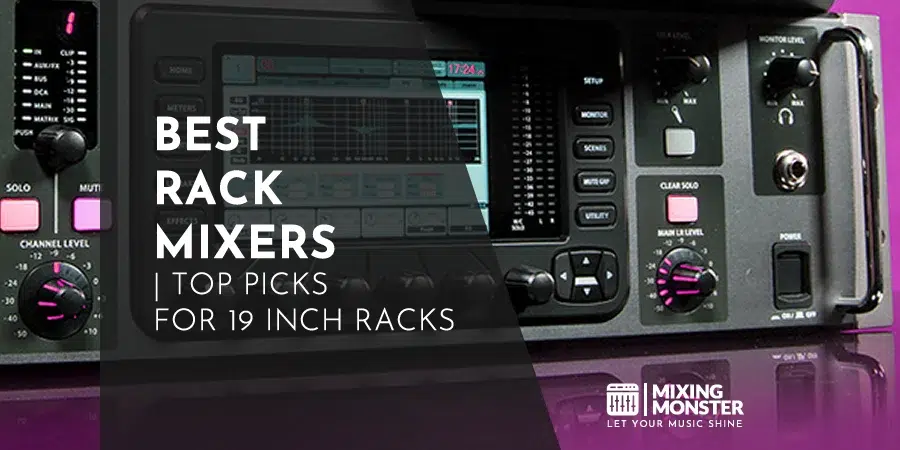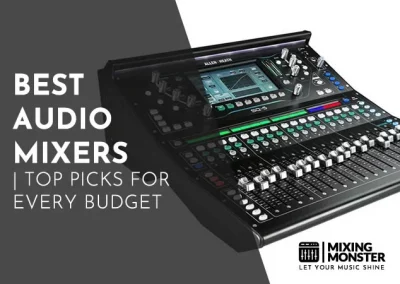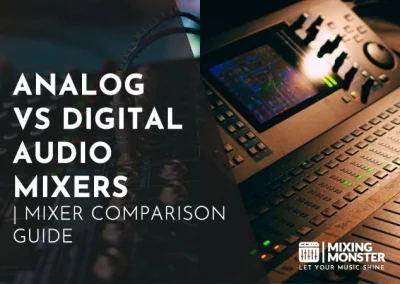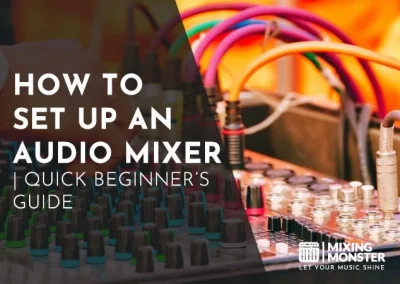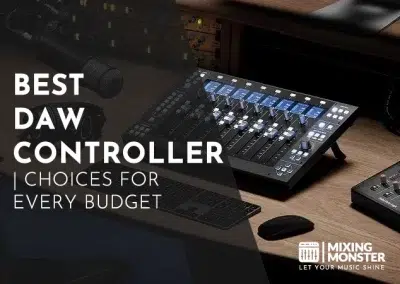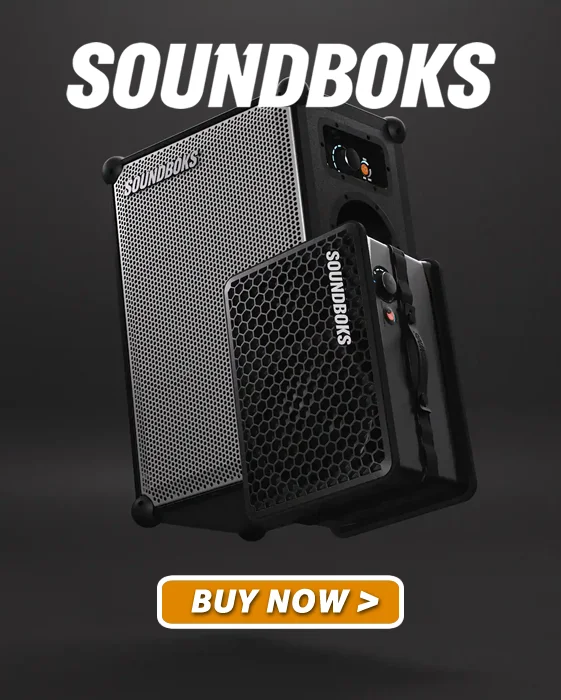Home > Blog > Studio Gear > Mixing Gear
Disclosure: Some of the links below are affiliate links, meaning that at no additional cost to you, we will receive a commission if you click through and make a purchase. Read our full affiliate disclosure here.
Rack mixers offer a practical way to streamline your audio setup, whether you’re working live or in the studio. Their design saves space and makes it easy to slot them into existing rack systems. That’s a big plus for anyone juggling multiple audio components.
Rack mixers are compact units built to fit standard equipment racks. The best rack mixers seamlessly blend essential mixing functions with sturdy construction, typically offering multiple channels, flexible routing, and both analog and digital connectivity options. Musicians, sound engineers, and venue operators all rely on these mixers for reliable and scalable solutions.
Picking the right rack mixer comes down to compatibility, channel count, input/output options, built-in effects, and reliability. You’ll also want to consider build quality and the interface, as quick adjustments are relatively common in live situations.
We selected rack mixers that strike a balance between must-have features, usability, and dependable performance. This guide breaks down what makes a rack mixer stand out and helps you determine which one best fits your setup.
We spent hours researching and checking out the latest rack mixers to find models that actually deliver solid control and flexibility.
KEYNOTES:
- In this article, you’ll find a comprehensive list of the best rack mixers on the market.
- Rack mixers are categorized into 3 sections:
Best Budget Rack Mixers
Best Midrange Rack Mixers
Best High-End Rack Mixers - Each section contains:
4 Rack Mixers
ordered by price (low > high) - In case you need a specific type of audio mixer, you might also be interested in:
Best Audio Mixers
Best Analog Mixers
Best Digital Mixers
Best PA Mixers
Best Summing Mixers
Best DJ Mixers
Best Podcast Mixers
Best Gaming Mixers
Our Top Picks – Best Rack Mixers
Best Budget
Behringer
X Air XR18
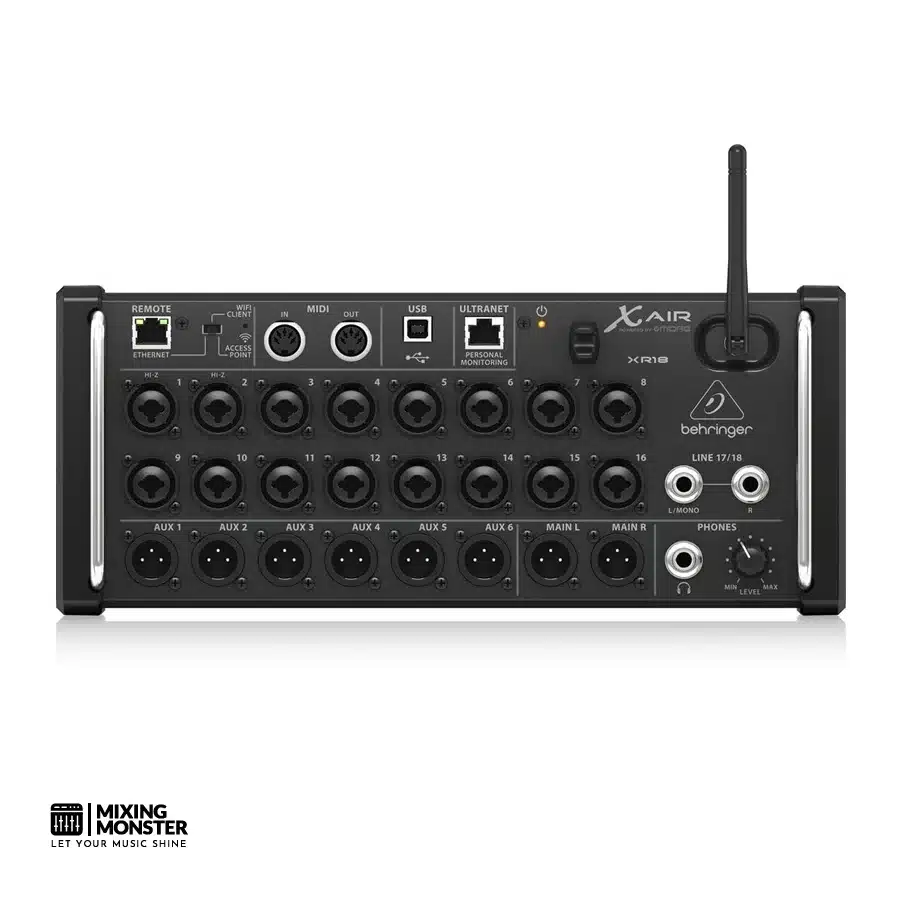
Best Midrange
Soundcraft
Ui24R
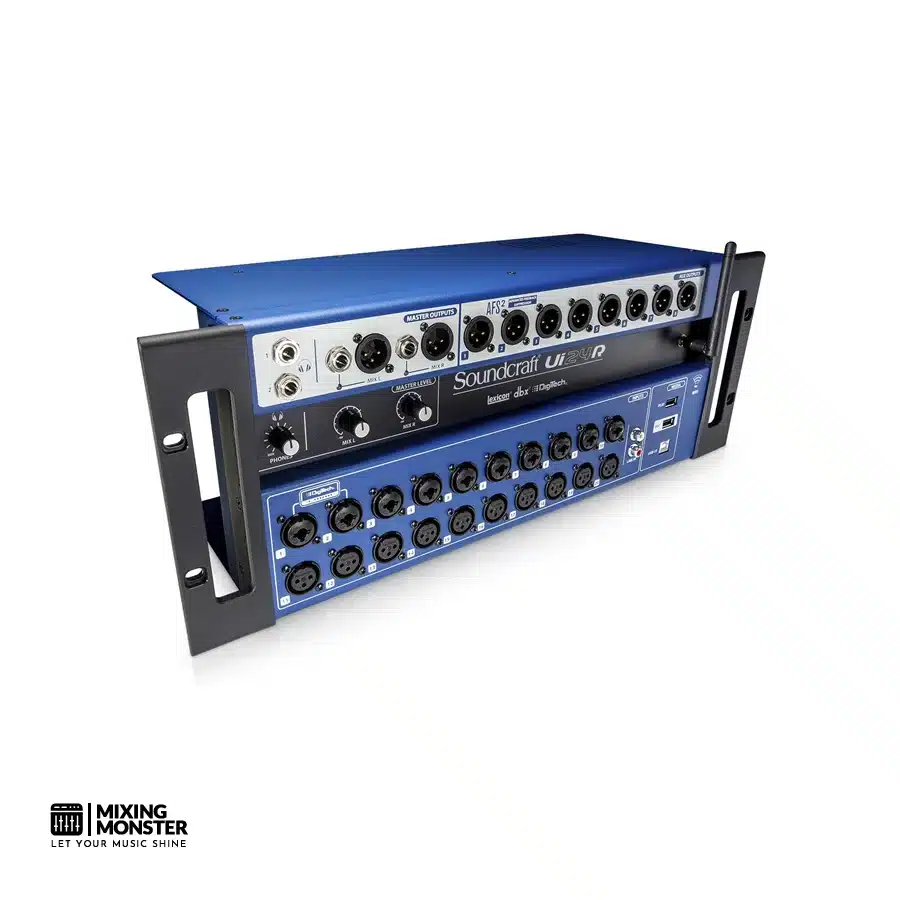
Best High-End
Allen & Heath
SQ Rack
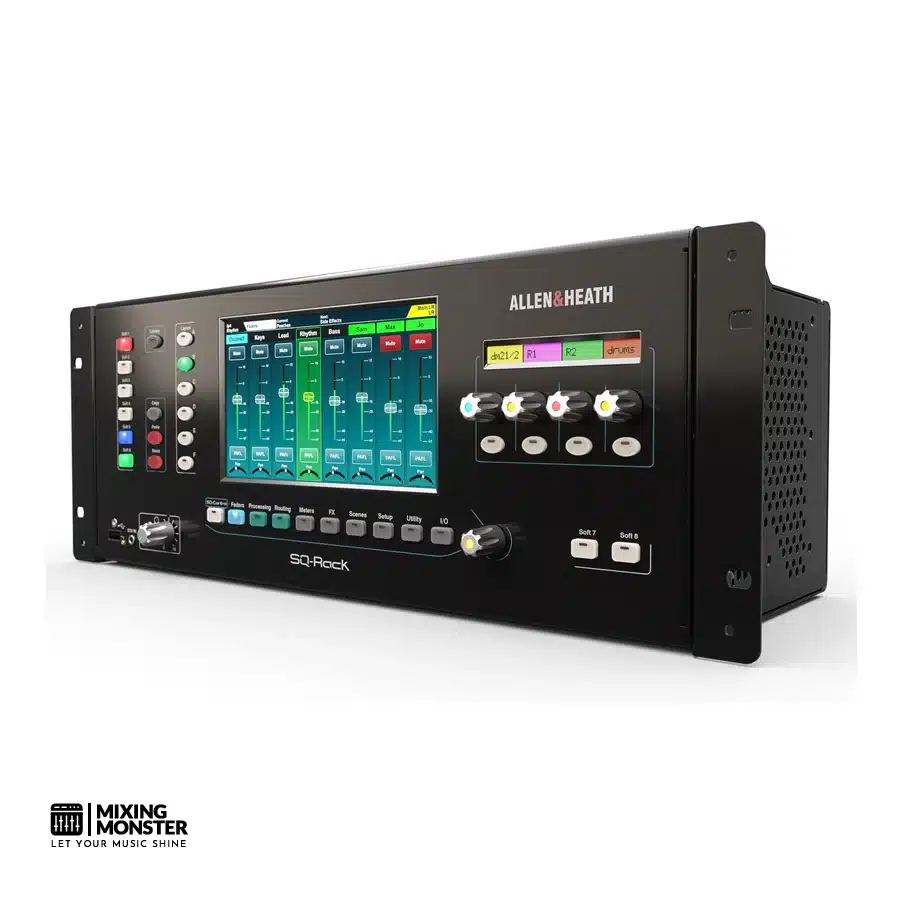
Table Of Contents
1. What Are The Best Rack Mixers?
Best Budget Rack Mixers
Best Midrange Rack Mixers
Best High-End Rack Mixers
2. What Is A Rack Mixer?
3. Essential Accessories To Complement Your Rack Mixer
4. Rack Mixer Buying Guide
5. Finding Your Perfect Rack Mixer: Key Takeaways
FAQ

1. What Are The Best Rack Mixers?
We’ve reviewed and compared the top rack mixers available today. Our list features reliable options that deliver consistent audio performance and practicality for both studio and live use.
Here Are Our Picks For The Best Rack Mixers:
Best Budget Rack Mixers
Best Midrange Rack Mixers
Best High-End Rack Mixers
12. Allen & Heath SQ Rack
Best For Superior Sound Quality And Compact Rackmount Use

Best Budget Rack Mixers
#1 Behringer RX1202FX V2
Best For Compact Analog Rack Setups In Live And Install Environments
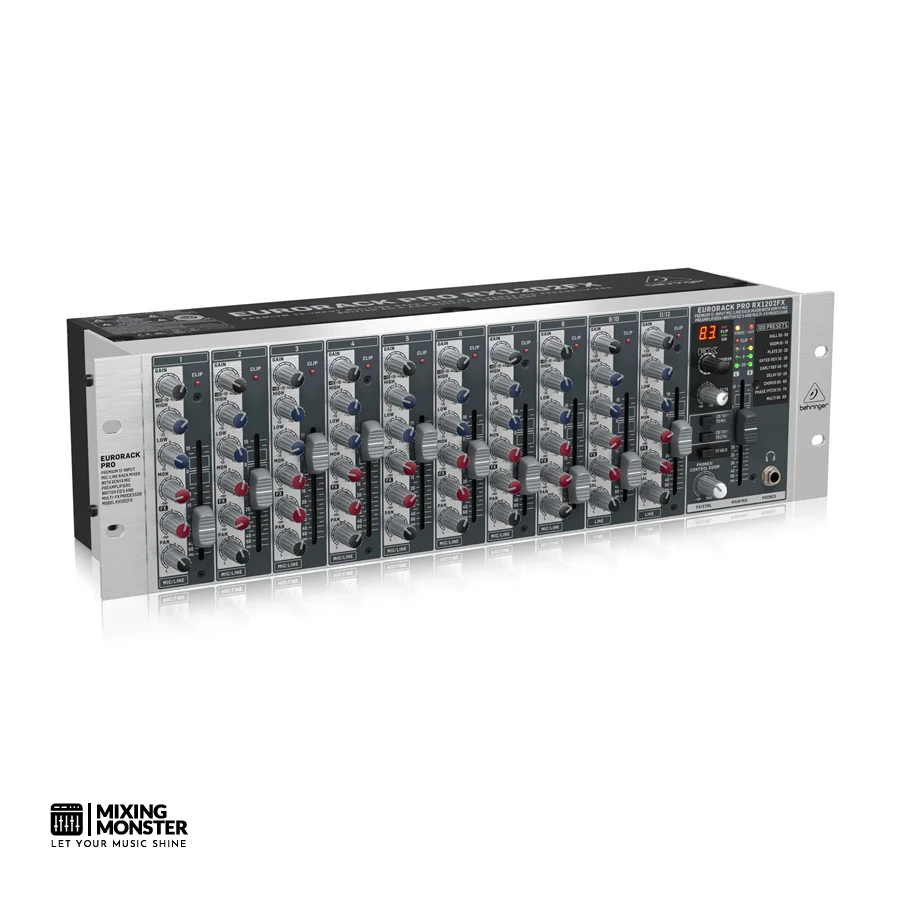
Overview:
The Behringer RX1202FX V2 Premium 12-Input Mic/Line Rack Mixer is an analog mixer that features ultra-low noise and high headroom, making it ideal for individuals seeking a reliable rack-mount solution.
With eight XENYX mic preamps and classic 2-band EQs, it seamlessly integrates into live events or permanent installations.
The built-in effects processor gives you creative options without extra gear. We found the mixer handled multiple sources smoothly, making it a practical pick for music venues and restaurants.
Pros:
- Quiet operation and substantial headroom even with all inputs in use.
- Rack-friendly form factor saves table space and fits securely.
- Onboard multi-effects engine cuts down on extra gear.
Cons:
- The effects section can introduce unwanted hiss in specific settings.
- Only a 2-band fixed EQ per channel—no fully parametric EQ.
- Build quality feels “functional” rather than premium.
Unique Selling Point:
The Behringer RX1202FX V2 stands out by packing eight XENYX mic preamps and a 100-preset multi-effects processor into a space-saving 3U rackmount design.
Key Benefits:
- Efficient Space Management: The rackmount size frees up workspace while handling up to 12 inputs, which is excellent for tight AV booths or mobile rigs.
- Integrated Effects: The onboard processor lets you add reverb, delay, or chorus directly, so you don’t need as many outboard units.
- Clean Preamps: The XENYX preamps offer plenty of gain and sound clean, preserving the natural character of microphones even at high levels.
Pricing:
| Average Price | ~ $219 |
Review:
Setting up the Behringer RX1202FX V2, we liked how straightforward and functional the interface felt. Main connections are easy to reach, and getting signal from mics, line gear, or laptops is intuitive.
We used it for both live PA and as the central hub for a restaurant’s AV system, and it stayed reliable day after day with no steep learning curve. The noise performance stood out the most in our workflow. Even with several mics and stereo sources plugged in, the noise floor stayed low.
Adjusting gain and levels felt accurate, and the output sent a clear, full signal to multiple amps. For mobile gigs, we recommend pairing it with a good rack case, as the build is sturdy but definitely utilitarian.
The multi-effects engine met our basic needs, such as reverb or chorus, although we did notice some hiss on specific effect presets at higher mix levels.
For critical situations, we reached for outboard effects, but for most gigs and installs, having built-in effects is just convenient. The simple 2-band EQ per channel is fine for basic shaping, but there were times we missed a midrange control for more precise tweaks.
All the controls are front-facing, which makes them accessible; however, you’ll want sufficient rack depth for comfortable operation.
The chassis handled weekly events and steady use well, although if you’re on the road frequently, a protective case is a wise investment. The Behringer RX1202FX V2 provides reliable mixing in a compact, rack-mountable package.
For venues, houses of worship, restaurants, or mobile DJs that require multiple mic inputs and quick mix adjustments, this mixer delivers substantial value and consistent results.
#2 Alesis Multimix 10 Wireless
Best For Compact, Wireless Rackmount Mixing For Mobile Systems And Small Venues
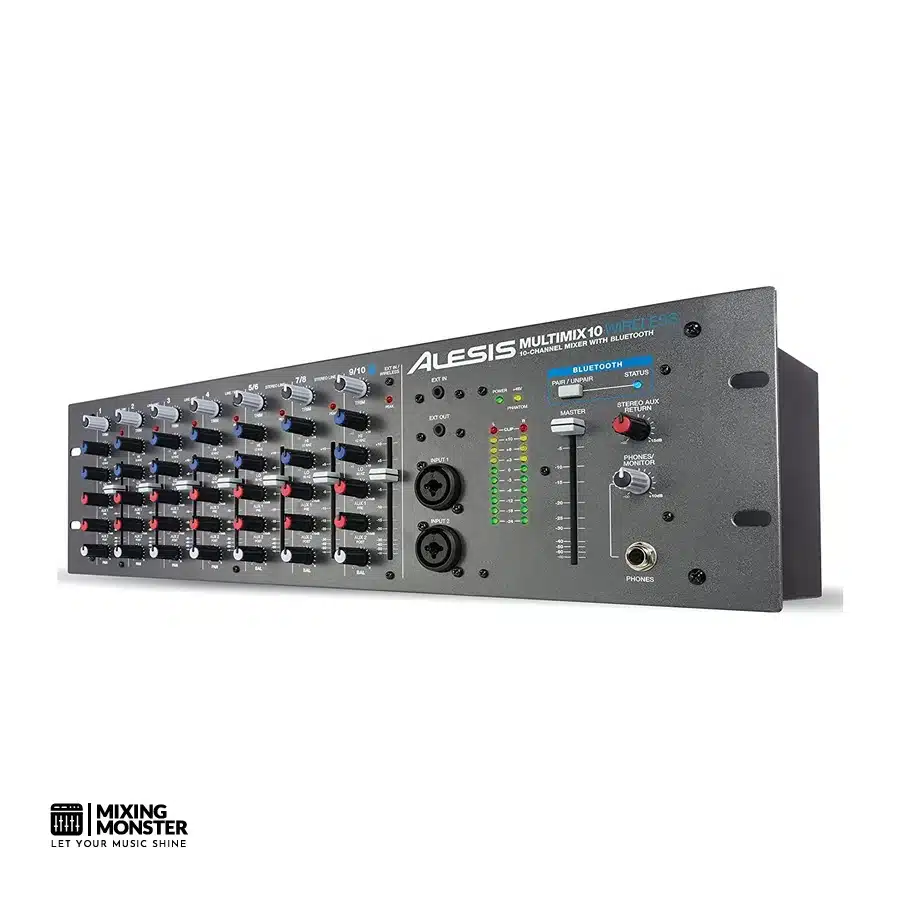
Overview:
The Alesis MultiMix 10 Wireless rackmount mixer brings wireless Bluetooth to a compact 3U form factor. It fits easily in tight racks and offers a flexible input scheme for small venues, clubs, and portable PA setups.
The front panel is user-friendly, so patching stays clear and accessible, which helps when swapping gear frequently. Bluetooth streaming is a real time-saver if you want to add background music from a mobile device without using up channels.
For straightforward and reliable mixing in a compact package, this Alesis rack mixer is ideal for daily use.
Pros:
- Bluetooth streaming adds flexibility for quick music playback.
- Multiple input types on the front panel enable fast setup and changes.
- Sturdy design fits well in travel racks or fixed installs.
Cons:
- No sweepable mid-EQ for detailed sound shaping.
- Metering could be more granular.
- No built-in digital effects.
Unique Selling Point:
The Alesis MultiMix 10 Wireless stands out by combining analog inputs with Bluetooth streaming, letting you mix wired and wireless sources at any event.
Key Benefits:
- Versatility: You can connect microphones, instruments, line gear, and mobile devices simultaneously, allowing it to adapt to a wide range of scenarios.
- Efficiency: Fast setup and clear labeling mean you spend less time troubleshooting and more time on the sound.
- Wireless Integration: Playing music from a phone or tablet between sets is easy, with no extra cables or adapters needed.
Pricing:
| Average Price | ~ $399 |
Review:
The Alesis MultiMix 10 Wireless has made our small venue gigs and portable PA rentals run more smoothly.
The rackmount-mount size doesn’t occupy valuable rack space, and the solid build withstands frequent loading and unloading.
Having mic, line, and RCA inputs on the front reduces confusion when we reconfigure gear.
Bluetooth integration is genuinely handy. Streaming music from a laptop or smartphone with just a button press made transitions between acts clean, and we didn’t have to mess with extra cables.
The Bluetooth antenna’s signal stayed strong—no annoying dropouts or interference—even in crowded places. This worked better than mixers that need wired aux or separate Bluetooth adapters.
Each channel gives you the basics without overcomplicating things. The faders have a smooth feel, and the two-band EQ helps quickly tame harshness or add a bit of warmth. The aux sends are well laid out for monitor mixes or outboard effects, although we would have liked a parametric mid control for trickier sources.
Monitoring is straightforward, with LED meters that give you quick feedback. Pre- and post-aux sends helped us run a floor monitor and an external effects loop simultaneously.
The dedicated headphone section on the front makes last-minute level checks easy. Please note that if you want built-in reverb or processing, you’ll need outboard gear.
The Alesis MultiMix 10 Wireless covers the essentials we want in a rack mixer for event sound and installs.
Its blend of reliability, flexibility, and wireless convenience makes it a practical choice for anyone seeking a hassle-free rackmount mixer that meets modern needs.
#3 Behringer X Air XR18
Best For Flexible Mixing For Live Bands And Mobile Studios

Overview:
We tried out the Behringer XR18 Rack Mixer and found it powerful and compact. It’s a digital mixer that suits bands or small events well, allowing them to streamline their audio setup.
This 18-channel, 12-bus mixer works seamlessly with iPad or Android tablets. We could walk around the venue and tweak the mix from wherever we wanted.
The MIDAS preamps genuinely surprised us with their clarity. Having built-in Wi-Fi lets us get up and running fast, no extra gear needed.
If you’re after a rack-mountable digital mixer with advanced features at a reasonable price, the XR18 stands out.
Pros:
- Wireless control means no more running cables to a mixing desk
- Programmable MIDAS preamps give clear and natural sound for live or studio use
- The multi-channel USB interface makes direct recording simple
Cons:
- The software interface can feel overwhelming for beginners
- Wi-Fi connection sometimes drops out in crowded or interference-heavy spaces
- No physical faders or knobs—some users really miss that hands-on feel
Unique Selling Point:
The Behringer XR18 combines high-quality MIDAS-designed preamps with full remote mixing capabilities from a tablet. You get advanced digital mixing in a portable, rack-friendly box.
Key Benefits:
- Wireless tablet control allows us to move freely and adjust the sound from any spot in the room.
- The 16 MIDAS preamps capture vocals and instruments with impressive clarity.
- We can handle multitrack recording of gigs and rehearsals easily with the built-in USB audio interface.
Pricing:
| Average Price | ~ $509 |
Review:
Working with the Behringer XR18 Rack Mixer, our sessions got a lot smoother. Controlling everything from an iPad felt liberating—we didn’t have to leave the stage or front of house to tweak a monitor mix or squash feedback.
The Wi-Fi integration is super handy in small venues or rehearsal spaces. It reduced the number of cables and clutter in our usual setups.
The audio quality impressed us, especially considering the price. We ran vocals and synths through the MIDAS preamps, consistently achieving a clean and detailed sound.
Recording multitrack audio straight to a laptop was a breeze with the onboard USB interface. There’s a learning curve to the software, especially if you’re new to digital mixers, but after a few sessions, it felt pretty intuitive.
We did notice some hiccups with Wi-Fi in crowded rooms, mainly when numerous devices competed for airspace. Switching to a hardwired Ethernet connection (when possible) instantly resolved the issue.
Some in our crew still miss physical faders and knobs. You’re working entirely in the digital realm here, which may not be for everyone.
Portability is a huge plus. The Behringer XR18 fits in a standard 19-inch rack case and is light enough to carry solo.
Setup at gigs is quick, and it quickly became our go-to for smaller clubs and mobile recording. Whether we’re running sound for a live band or tracking demos in the studio, it gives us the flexibility and sound quality we need.
#4 Tascam MZ-223
Best For Flexible Multi-Zone Audio Routing In Compact Spaces
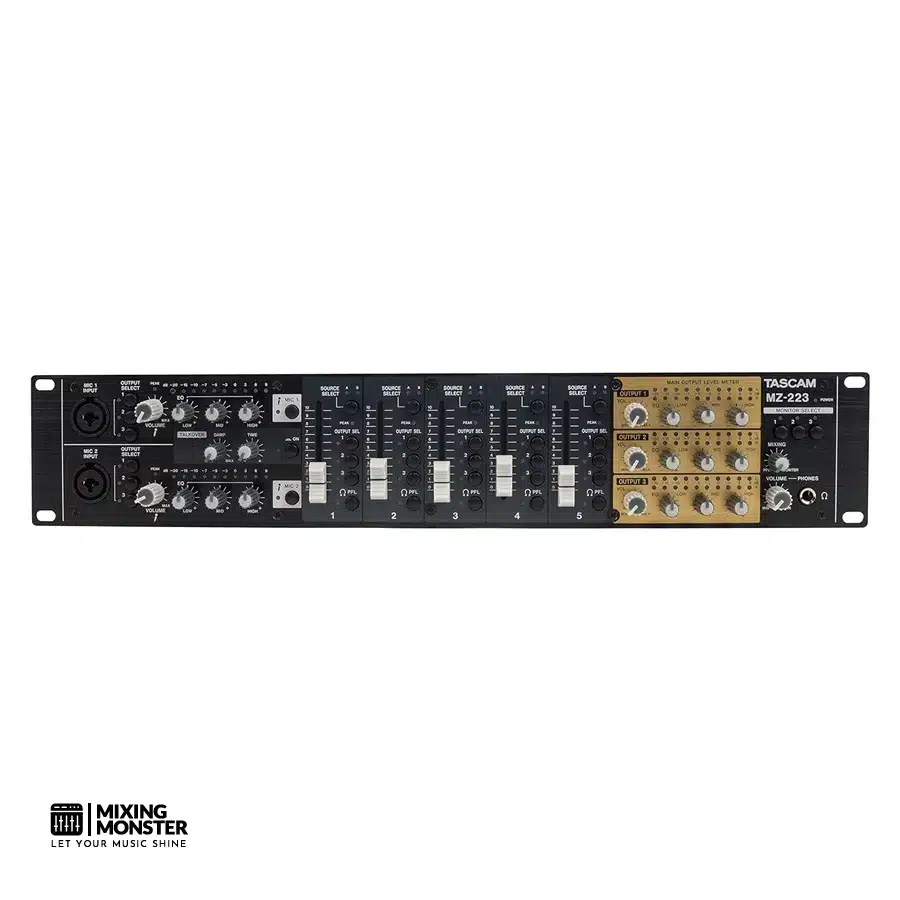
Overview:
The Tascam 7-Channel 3-Zone Rackmount Audio Mixer With Voice Priority (MZ-223) handles multi-source audio management for small installs, studios, or anywhere you need separate zone control.
We gave the Tascam MZ-223 a shot and found the hands-on controls intuitive, with a tidy front panel that makes switching sources easy.
This 2U rackmount unit strikes a nice balance between features, compact size, and solid build. It’s great for users who want to route different audio to separate zones without a headache.
It’s not perfect, but the MZ-223 stands out for flexibility and ease of integration.
Pros:
- Handles a wide range of sources with simple front panel controls
- Compact 2U design saves precious rack space
- Lets you keep multiple zones cleanly separated
Cons:
- No integrated preamp for specific sources
- Pots and buttons can feel delicate and might get noisy with time
- No separate left/right balance for each output
Unique Selling Point:
The Tascam MZ-223 stands out by offering straightforward multi-zone routing and mixing, along with front-panel source selection. It’s all packed into a compact rackmount unit that’s ideal for small venues or distributed systems.
Key Benefits:
- Multi-Zone Flexibility: Route different sources to three zones with no rewiring headaches.
- User-Friendly Operation: Change sources and outputs with clear sliders and buttons.
- Versatile Input Support: Connect microphones, turntables, and more with ease.
Pricing:
| Average Price | ~ $599 |
Review:
Using the Tascam MZ-223, we found managing different audio feeds in our setup way easier. Right after installing it, the compact chassis and organized layout stood out—no more fumbling with tangled cables or awkward rear-panel switches.
The front sliders and buttons put routing control right at our fingertips. Assigning music, microphones, or even a turntable to any zone took seconds.
The mixer handled simultaneous audio in multiple zones without breaking a sweat. We set up music in one room, a microphone for announcements in another, and a separate feed to a recorder simultaneously.
The dedicated stereo master output for recording made it easy to capture live events—no drama, plug and go.
We encountered a couple of limitations. Without an onboard preamp, some quieter sources required external assistance, and increasing the gain too high introduced additional noise.
Some control knobs felt a bit flimsy, and we’ve heard they can get noisy or loose over time. Adjustments were usually precise, but not having independent left-right balance per output was a little frustrating during detailed setups.
Integration with other gear went smoothly. Connecting microphones, computers, and media players to the Tascam MZ-223 was straightforward, making it easier to juggle audio for events or background music.
The build felt sturdy enough, though a few buttons seemed delicate after heavy use.
Best Midrange Rack Mixers
#5 Zoom LiveTrak L-20R
Best For Wireless Control And Multitrack Recording On Stage
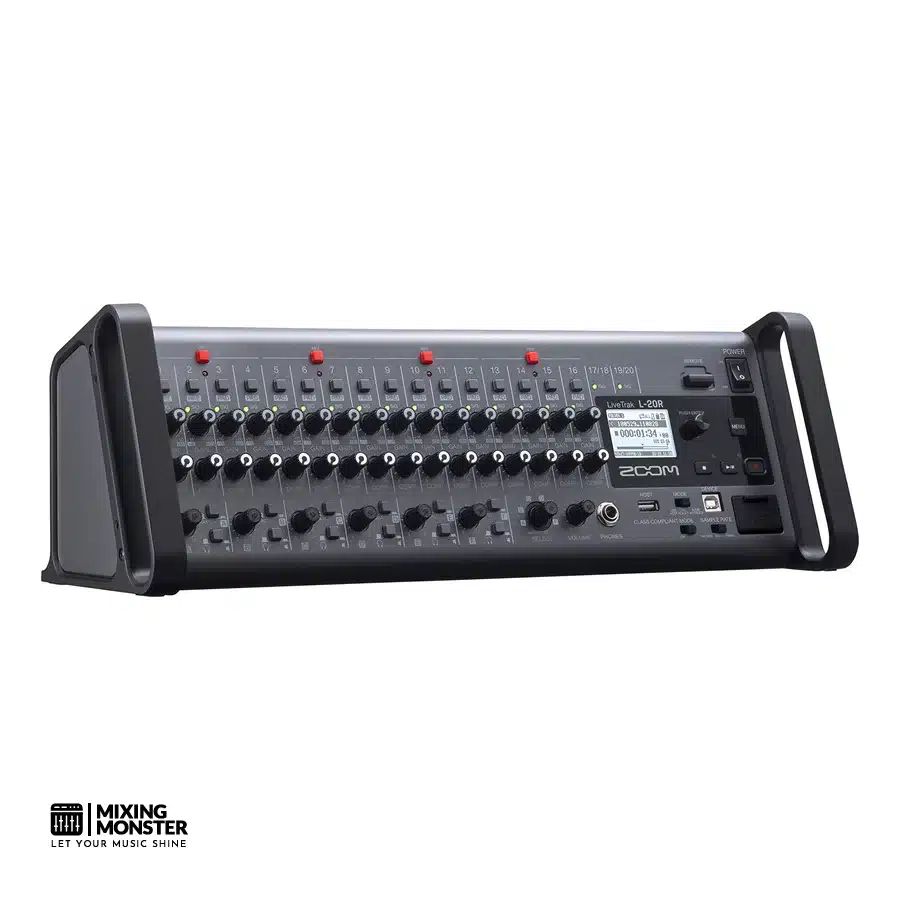
Overview:
The Zoom LiveTrak L-20R is a rack-mountable digital mixer and recorder. It’s designed for musicians and live sound professionals who want to control their mix remotely.
With 20 channels, multiple monitor mixes, and onboard recording, it adapts easily to all sorts of live venues. We especially liked the wireless control via iPad—it’s honestly a game changer and saves a lot of running back and forth during shows.
The build feels sturdy, just as you’d expect from Zoom. The streamlined workflow helps keep things quick and focused.
Pros:
- Wireless remote mixing via iPad streamlines live workflow
- Built-in multitrack recording functions flawlessly
- Plenty of mix outputs for different monitor mixes
Cons:
- Physical controls are minimal—managed mainly by touchscreen
- Requires an iPad for the whole remote operation
- Doesn’t fit perfectly into standard 3U rack bays due to a slight size difference
Unique Selling Point:
The Zoom LiveTrak L-20R enables us to handle a full-band live mix and record up to 22 tracks simultaneously to an SD card. We can do all this remotely from an iPad, which is rare among rack mixers.
Key Benefits:
- We can customize up to six monitor mixes, so every band member gets what they want in their ears.
- Multitrack recording offers us flexibility for post-show editing and capturing studio-quality sound on every channel.
- Wireless operation allows us to adjust the sound from anywhere in the venue using the iPad app.
Pricing:
| Average Price | ~ $799 |
Review:
Using the Zoom LiveTrak L-20R, we found mixing live gigs got way more efficient. Installing it in our rack was relatively easy, but it does protrude slightly—just something to note if you’re concerned about achieving a perfectly flush look.
Setup was quick, and connecting the iPad for remote control took just a minute. The app’s interface feels intuitive, although getting used to virtual faders on a touchscreen takes some time.
Recording is where this thing really shines. We captured each channel straight to an SD card, so we didn’t need to lug around extra recorders. Exporting tracks to a DAW afterward went smoothly.
Sound quality remained high across all inputs, and having numerous output options meant that each musician could have their own monitor mix without any fuss.
The iPad reliance is really the main downside. If the tablet’sn’t nearby, you can’t make quick hands-on adjustments, which can be frustrating in the heat of the moment.
There’s a learning curve with virtual mixing compared to physical faders. But once you get the hang of it, the workflow is fast and keeps us off the stage during shows.
The stability of the Zoom LiveTrak L-20R has been solid with barely any glitches. The effects engine covers basic live needs; however, if you want deep processing, you may want to add some external gear.
#6 Behringer X32 Rack
Best For Flexible Live Sound Mixing In Compact Spaces
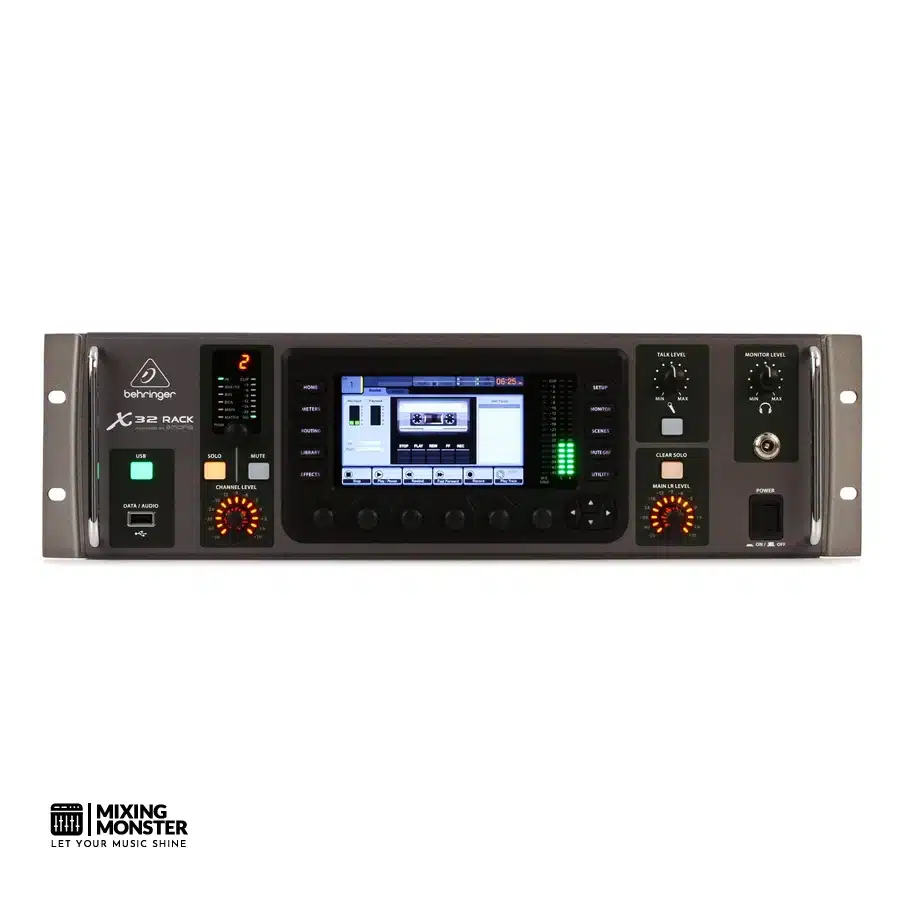
Overview:
We’ve spent plenty of time with the Behringer X32 Rack Digital Mixer, and its versatility is immediately apparent. Behringer designed this 40-input, 25-bus rack console for people who want big-board digital power in a compact space.
Remote control via iPad or iPhone adds significant value, whether you’re in the studio or performing live gigs. Moving from a desktop board to this rack unit was simple, and we liked that it offered depth without being overwhelming.
Pros:
- Extremely compact yet powerful
- Remote mixing via mobile devices is intuitive
- Excellent value for the feature set
Cons:
- Initial setup requires a learning curve
- Built-in Wi-Fi can be inconsistent
- No onboard physical faders
Unique Selling Point:
The Behringer X32 Rack Digital Mixer stands out for its advanced digital mixing features and complete remote control in a small rack unit. It’s just as comfortable in a live venue as it is in a permanent installation.
Key Benefits:
- Remote management allows us to adjust mixes anywhere in the venue, making live shows less stressful.
- The virtual FX rack provides us with premium effects without requiring additional gear.
- The compact form saves rack and control room space without compromising on channel count or routing.
Pricing:
| Average Price | ~ $980 |
Review:
With the X32 Rack, we immediately noticed the significant amount of desk space we saved. The power of a full-size X32 fits neatly in a 3U rack, making it easy to transport and install.
Remote mixing and live sound checks became much smoother. We routed multiple monitor mixes, hooked up outboard gear via USB, and used the virtual FX rack for onboard processing—it handled complex setups without breaking a sweat.
Controlling everything from a tablet changed the game for us, especially when setting stage levels or troubleshooting. The learning curve was real, though. Configuring routing and stabilizing Wi-Fi took several tries.
Once we had the network set up, we experienced minimal operational hiccups. The built-in Wi-Fi isn’t always reliable, so for critical gigs, we recommend using a wired network.
No physical faders can be an adjustment if you’re used to analog or surface-style mixers. For us, mixing on the iPad felt natural after a week or two; however, some people might initially miss the tactile controls.
The upside? More rack space for amps or wireless receivers, which is a fair trade in tight rigs.
The X32 Rack offers a solid mix of features and practicality. In studios, houses of worship, or busy venues, it replaced larger mixers without any drama.
#7 Soundcraft Ui24R
Best For Flexible Wireless Control And Professional Sound In Live And Studio Settings

Overview:
The Soundcraft Ui24R is a rack-mountable digital mixer with features for both live and studio work. We appreciated the robust wireless control and premium Studer preamps—it made mixing intuitive and the audio clear.
Dual-band Wi-Fi and flexible inputs made setup easier, allowing us to link up to ten control devices simultaneously. That really boosted our efficiency on busy gigs.
The mixer fits securely in standard racks, so transport and integration were painless.
Pros:
- Wireless control from multiple devices for hassle-free adjustments anywhere in the venue
- Clean, powerful sound with impressive built-in processing and feedback suppression
- Durable build and compact design fit most professional setups
Cons:
- Initial setup can be tricky, especially configuring Wi-Fi with networks on-site
- The interface, while feature-packed, takes some time to understand fully
- No physical fader controls, which may slow down live tweaking for some users
Unique Selling Point:
The Ui24R‘s web-based wireless control lets us run the entire mix remotely from tablets, phones, or laptops. That keeps the mixing station flexible and untethered, which is a relief during fast-paced events.
Key Benefits:
- Remote Operation: We can manage mixing from anywhere in the room—makes it easy to hear what the audience hears and adapt on the fly.
- Scalable Inputs and Outputs: It handles a full band or ensemble with plenty of connections and channels.
- Reliable Sound Processing: Built-in dbx, Lexicon, and DigiTech effects provide a polished mix without the need for extra hardware.
Pricing:
| Average Price | ~ $1287 |
Review:
We’ve used the Soundcraft Ui24R at several live gigs and recording sessions. Being able to connect up to ten control devices meant we could dial in monitors and FOH mixes from different spots, just using our phones and tablets.
This flexibility saved us time and made sound checks smoother, even with a small crew. The Studer preamps stood out for vocals and acoustic instruments—they delivered a clear, robust sound with no unwanted noise.
Having Lexicon reverbs and dbx processing built in meant we didn’t need to bring extra processors or plugins. Automatic feedback suppression was a lifesaver for live events, especially in venues with tricky acoustics.
Multitrack recording directly to USB was easy, allowing us to capture all channels for post-production. The touchscreen web interface provided us with deep control, but it took a bit to get comfortable—especially when making detailed tweaks between sets.
The biggest downside is the lack of physical faders, which some engineers might miss for quick hands-on changes. Once we got used to it, though, touch control felt natural enough.
The Soundcraft Ui24R blends a modern workflow with dependable audio quality. We recommend it to bands, engineers, and venues seeking a rugged, flexible, and great-sounding solution—without the need for extra gear.
#8 Midas DL32S
Best For Professional Stage Use, Large Live Sound Events, Or Studio Integration
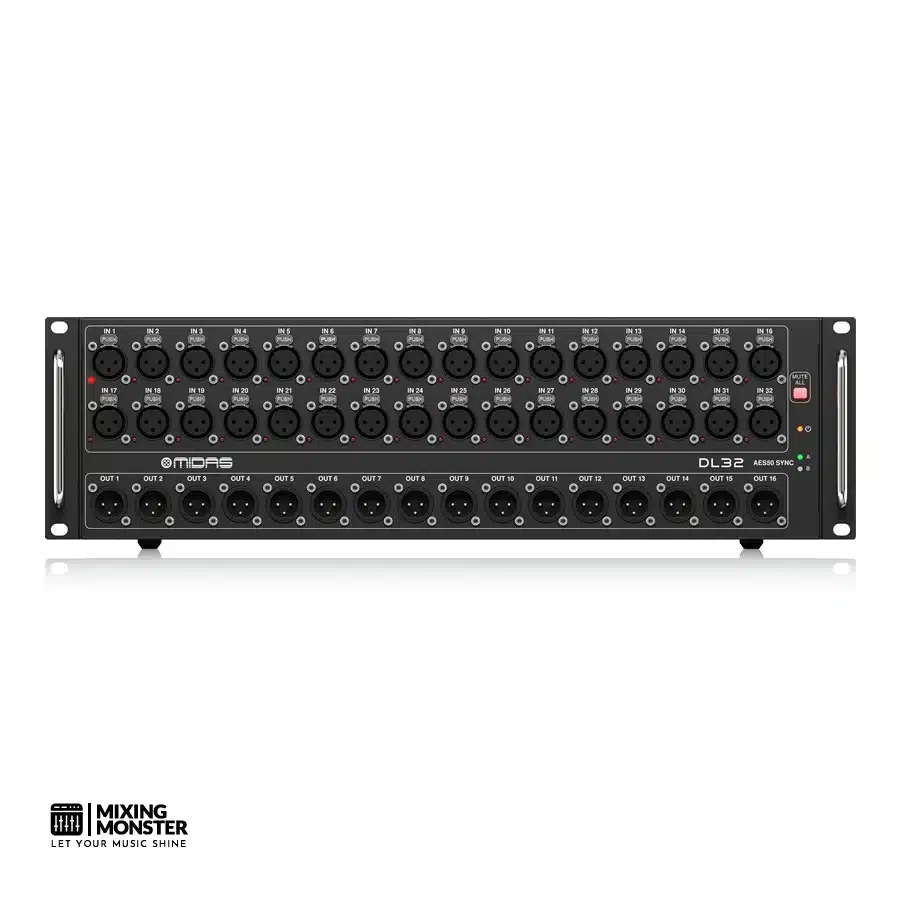
Overview:
The Midas DL32 32 Input, 16 Output Stage Box is built for demanding live gigs and studio setups. It comes equipped with 32 Midas PRO mic preamps and switchable phantom power, providing a significant boost in input options for any compatible digital mixer.
We ran it through several live events, pairing it with digital desks and personal monitor systems. Its connectivity and sound quality really shine for event engineers or permanent installs.
The build feels solid—reliability wasn’t an issue, even after repeated use.
Pros:
- Superb preamp quality offers clear, detailed audio capture
- Simple setup and seamless integration with Midas and Behringer systems
- Extensive connectivity options, including ULTRANET for personal monitoring
Cons:
- Bulky and heavy, which makes it less portable
- Learning curve if you’re not familiar with digital stage boxes
- Price can be high compared to smaller or less feature-rich units
Unique Selling Point:
The DL32 stands out with its 32 Midas PRO preamps and built-in ULTRANET. This combo enables us to manage complex in-ear setups and multiple devices while maintaining that signature Midas sound.
Key Benefits:
- Expanded Channel Count: This feature provides 32 high-quality microphone inputs, making it ideal for larger bands or orchestral gigs.
- Flexible Output Routing: With 16 line-level returns and several digital formats, we routed signals to monitors, front-of-house, and recorders without a hitch.
- ULTRANET Connectivity: Setting up personal monitoring for musicians was quick and didn’t need extra gear, which made show days less stressful.
Pricing:
| Average Price | ~ $1579 |
Review:
When we used the Midas DL32, we noticed a significant increase in channel headroom and flexibility during rehearsals and shows. The preamps delivered clean, accurate sound with ample gain, which greatly helped with sensitive microphones in quieter settings.
Pairing it with Midas or Behringer desks was straightforward. AES50 cabling lets us chain multiple stage boxes without the networking headaches.
Assigning channels or tweaking configurations before a gig was a fast process. The interface just made sense, so changes on the fly didn’t slow us down.
The rackmount design does add weight, so if you’re moving between venues, plan for transport or installation.
Setting up a personal monitor with ULTRANET was a breeze. Artists liked the sound and speed, and our team didn’t need to run extra cables or hardware.
If you’re new to digital stage boxes, the setup of the Midas DL32 can seem overwhelming at first. There’s a lot to connect and configure, but once you get the hang of it, the payoff is obvious.
Best High-End Rack Mixers
#9 Presonus StudioLive 32R
Best For Networked Live Sound And Flexible Stage Monitoring
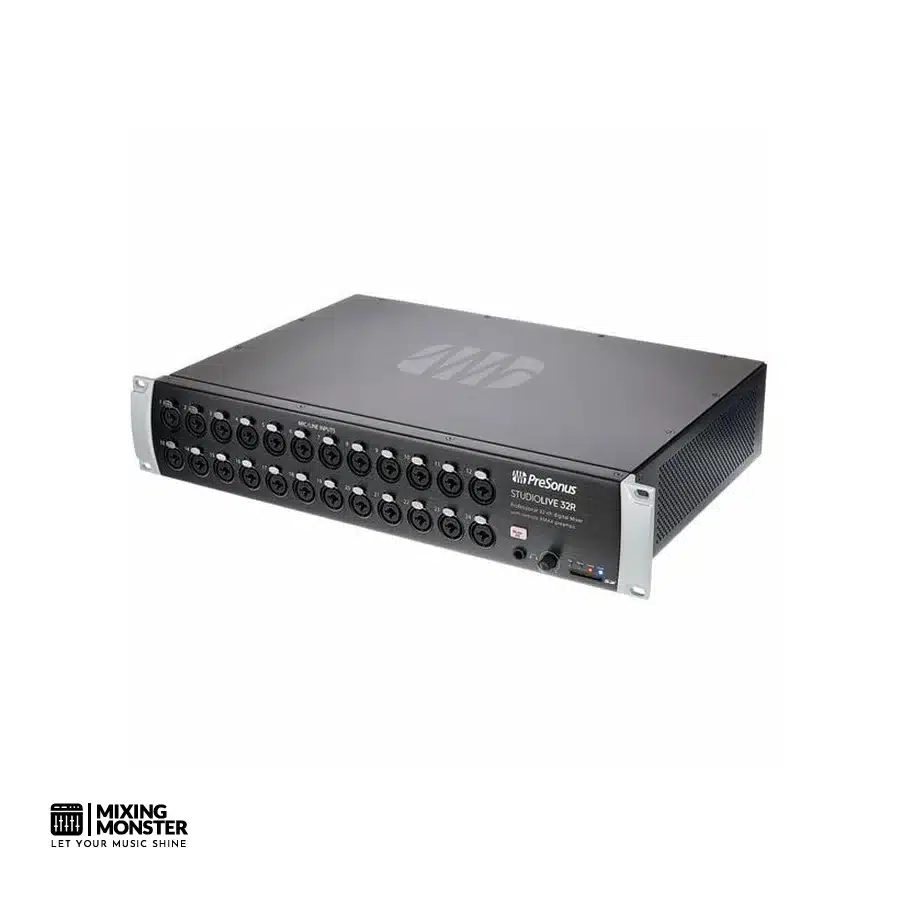
Overview:
The PreSonus StudioLive 32R Stage Box Bundle strikes a sweet spot between flexibility and power, catering to both stage and recording applications. We recently integrated it with a StudioLive console, and it functioned as both a stage box and monitor mixer in our rig.
PreSonus’ AVB networking made cabling painless. The control software let us adjust headamps and mixes remotely without any drama.
This unit fits into a 2U rack space, saving space while still delivering a powerful performance.
Pros:
- Integrates smoothly with PreSonus Series III consoles over AVB networks
- Compact 2U design for easy rack mounting and portability
- Powerful remote control options via versatile software
Cons:
- Learning curve with the initial network setup
- Slightly bulkier than some digital-only alternatives
- Price may not fit casual or small venue budgets
Unique Selling Point:
The StudioLive 32R stands out because it serves as both a networked stage box and a full-featured monitor mixer. You can control every function remotely over AVB with PreSonus’ software suite.
Key Benefits:
- Streamlined setups with a single Ethernet cable reduce stage clutter and minimize analog signal loss.
- We could tweak mixes in real time from any device on the network, which made managing performances much smoother.
- The compact 2U size made transport and rack installation simple, even in cramped spaces.
Pricing:
| Average Price | ~ $1699 |
Review:
When we got the StudioLive 32R up and running, the flexibility stood out right away in both our live and studio setups. Connecting it to our Series III console with a single Ethernet cable saved us a significant amount of hassle compared to using old-school copper snakes.
AVB networking came together quickly after we got past the initial learning curve. The signal stayed clean, and we overlooked any noise or latency issues.
The 2U rack unit slid into place with no fuss, which is a relief when space is tight. Having 32 channels without needing a huge box meant we could mic everything we wanted.
The included software—UC Surface, QMix-UC, and Studio One Artist—was actually helpful. We made remote changes, utilized touch control, and handled multitrack recording without any issues.
We created multiple monitor mixes in real time, which made things easier for the band and improved communication on stage.
Remote control over preamps and phantom power from the console made sound checks significantly faster. No more running back and forth to adjust inputs.
The system’s flexibility lets us reassign mixes quickly, which is a lifesaver for those inevitable last-minute changes.
Getting comfortable with AVB networking took some digging. It’s not plug-and-play like an analog mixer so that new users may need patience.
The build is solid, but it’s not the lightest option available. If you travel frequently and have limited carrying space, that’s something to consider.
The price of the StudioLive 32R was justified by the pro features and build, but it might be overkill for small bar gigs or hobbyists. For us, the StudioLive 32R became a core part of our live and studio rigs, and we’d recommend it to anyone who needs real digital mixing power in a rack-friendly format.
#10 Behringer WING Rack
Best For Advanced Digital Mixing With Maximum Flexibility
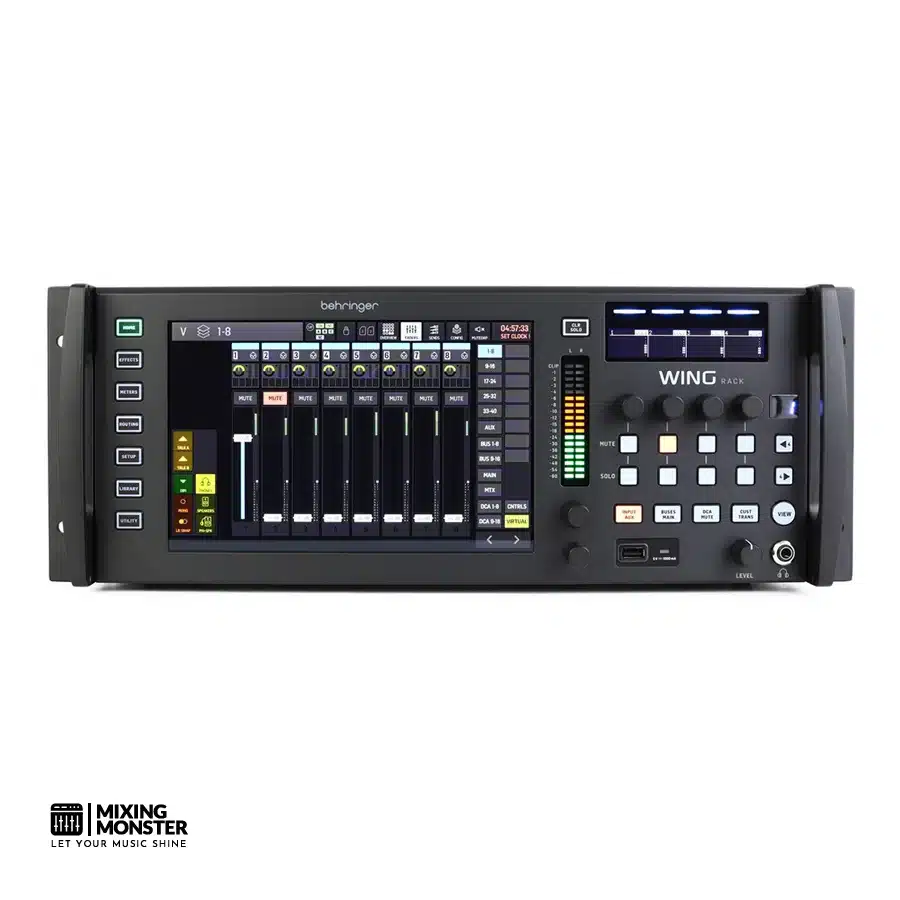
Overview:
The Behringer WING Rack 48-channel Digital Mixer brought a ton of versatility and power to our rack setup, all in a surprisingly compact chassis. We ran it through its paces in both busy live and studio environments and immediately noticed the blend of flexibility and high-grade audio.
The touchscreen is intuitive, and remote control options really stand out. With 24 Midas Pro preamps built in, we rarely find ourselves reaching for outboard gear.
Recording multiple channels straight to SD cards made our workflow way smoother and gave us peace of mind that we’d capture every detail. Behringer clearly set out to squeeze flagship features from their WING console into a rackmount frame—and for the most part, they nailed it.
Pros:
- The touchscreen interface feels snappy and makes navigation quick
- Built-in Midas Pro preamps deliver clean, excellent audio quality
- Direct-to-SD recording makes multitrack capture a breeze
Cons:
- The menu system can get dense, especially for first-timers
- Pretty heavy for portable rigs
- Need optional cards for Dante connectivity
Unique Selling Point:
The Behringer WING Rack 48-channel Digital Mixer packs the full power of the WING console, including remote control and a 48-channel USB audio interface, into a format that actually saves you a ton of rack space.
Key Benefits:
- Easy access and control via a 10.1-inch touchscreen or remotely through computers and mobile devices. This significantly reduces setup and adjustment time during sessions.
- Twenty-four high-quality Midas Pro preamps are built in, so you don’t need a separate stage box. That keeps the signal path clean and straightforward.
- Multitrack recording to SD cards enables you to capture live events reliably, eliminating the need for an external computer or recorder.
Pricing:
| Average Price | ~ $1799 |
Review:
We dropped the Behringer WING Rack 48-channel Digital Mixer into our live sound workflow and were honestly surprised by its advanced capabilities in such a compact package.
Navigating mixes through the touchscreen felt straightforward once we got the hang of it, and the remote control proved to be an absolute lifesaver in larger venues.
The audio quality from those 24 Midas Pro preamps consistently impressed us. Inputs sounded clean, whether we were tracking delicate studio parts or running a hectic stage mix.
Recording up to 64 channels directly onto SD cards? That changed the game for us. We could capture entire performances without any fuss.
Setup took a little longer than we had hoped, mainly because the menu navigation was initially complex. However, after some hands-on time, routing and configuration began to make sense—especially once we became accustomed to the Sources paradigm.
The onboard effects sounded rich and usable right away. We didn’t need to haul as much outboard processing gear, which was a relief.
The Behringer WING Rack is a bit on the heavy side, so if you’re moving it a lot, you’ll want a team. Full Dante connectivity needs an optional card, but the USB interface covers most modern routing needs anyway.
#11 Yamaha TF-Rack
Best For Space-Conscious Studio Engineers Seeking Intuitive, Reliable Mixing Solutions
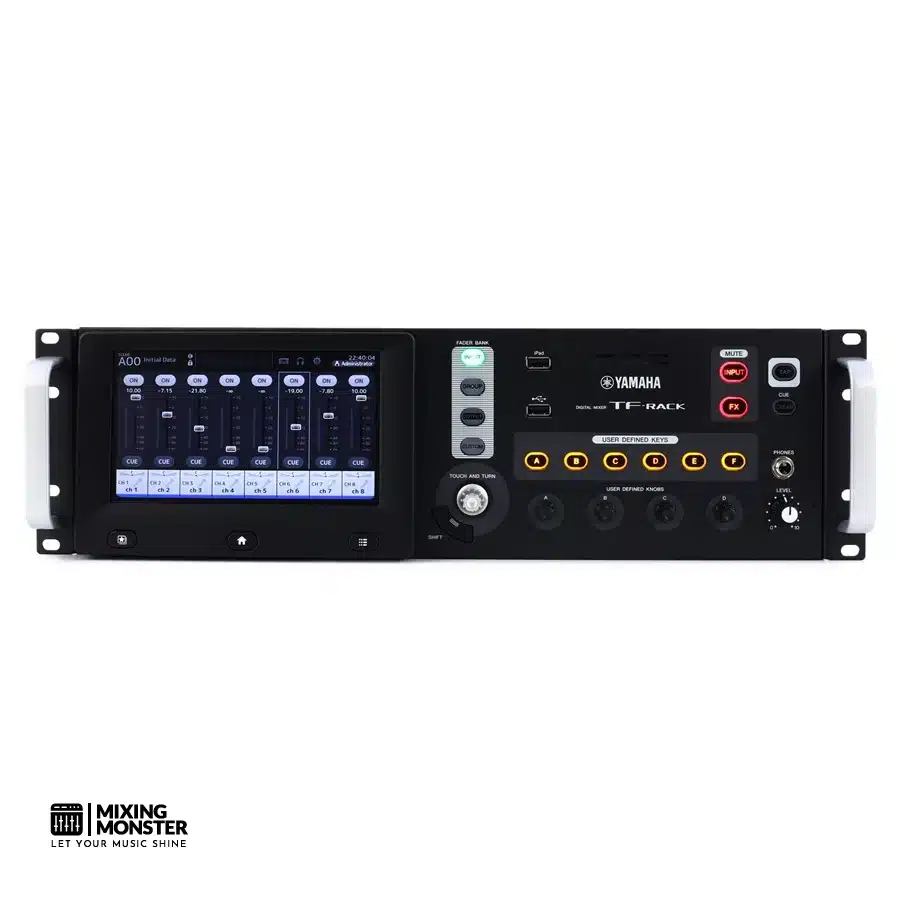
Overview:
The Yamaha TF-Rack is a compact, rackmount mixer that brings the same powerful features as Yamaha’s full-sized TF Series consoles. We found it perfect for setups where desk space is tight.
This makes it a wise choice for studios or live rigs that need flexibility but can’t spare the space for a large desk. QuickPro presets and scene memory made setup and sound recall fast during our tests.
The interface and controls felt smooth and approachable, whether we were working on basic mixes or more complex projects.
Pros:
- Streamlined, space-saving design fits easily into existing racks
- Scene memory sped up our workflow and made quick changes easy
- Preset sound setups saved us serious time dialing in mixes
Cons:
- A smaller interface can feel cramped for detailed tweaks
- No motorized faders, unlike some bigger consoles
- Heavy reliance on digital menus might slow down analog-first users
Unique Selling Point:
The Yamaha TF-Rack stands out as a super-adaptable, compact digital mixer. It’s built for individuals who want both portability and deep control—perfect for spaces where every inch of rack space is valuable.
Key Benefits:
- Delivers full console mixing power in a rackmount size, making operations way easier in tight spaces.
- Fast scene recall lets us switch setups quickly between sessions or gigs.
- A preset-driven workflow enables quick and reliable professional sound results, even for those new to the field.
Pricing:
| Average Price | ~ $1999 |
Review:
We dropped the Yamaha TF-Rack into our rack and immediately noticed the significant amount of bench space we saved. Even with its small footprint, the TF-Rack retains the critical features we expect from Yamaha’s TF Series, including scene saves, QuickPro profiles, and more.
As folks who need fast turnarounds, scene memory significantly reduces our setup time. We could recall complex mixes in seconds, which was a huge help.
The control surface felt intuitive almost right away. The touch interface and simple navigation let us tweak things on the fly without getting bogged down.
For more detailed tasks—such as fine EQ adjustments or multi-channel routing—the limited physical controls felt somewhat cramped compared to a full-sized console.
We relied heavily on the QuickPro presets. Whether running live sound or a studio project, those presets provided a solid starting point, especially for newer engineers or freelancers getting acquainted with the room.
In both rehearsals and events, the stability and sound quality met our expectations of Yamaha hardware. Integration was seamless, too.
Connecting outboard gear to the TF-Rack, recalling past shows, making system tweaks—it all just worked. If you’re coming from an analog-only background, the digital menus might take some getting used to, but once we got into the workflow, the interface felt consistent and logical.
#12 Allen & Heath SQ Rack
Best For Superior Sound Quality And Compact Rackmount Use

Overview:
The Allen & Heath SQ Rack 48 Channel Digital Mixer is a professional-grade rackmount mixer designed for live sound, studio work, and installations.
Built on Allen & Heath’s 96kHz XCVI FPGA engine, the SQ Rack delivers pristine audio quality with remarkable headroom and low latency.
We found it to be an excellent solution for musicians and engineers who want the power of the SQ series in a compact, portable rack format. Its intuitive routing and integration with apps like Mixing Station make it both powerful and practical.
Pros:
- Outstanding 96kHz sound quality with impressive clarity
- Compact rackmount design for portability and installations
- Seamless integration with remote mixing apps
- Flexible routing and multitrack recording options
- Reliable build quality from a trusted brand
Cons:
- Limited onboard effects compared to some competitors
- A multitrack recording setup requires extra steps.
- Higher price point than entry-level rack mixers
- Smaller interface learning curve for beginners
Unique Selling Point:
The Allen & Heath SQ Rack‘s unique selling point is its ability to deliver the same 96kHz XCVI FPGA processing found in the SQ5 and SQ6 consoles, but in a compact rackmount format—making it ideal for touring musicians, engineers, and venues that need top-tier sound in a portable package.
Key Benefits:
- Superior Audio Quality – The 96kHz engine ensures crystal-clear mixes and professional-grade sound.
- Space-Saving Design – Rackmount format makes it easy to integrate into touring rigs or studio racks.
- Remote Mixing Capability – Compatible with Mixing Station and SQ apps, allowing wireless control from tablets or smartphones.
Pricing:
| Average Price | ~ $2439 |
Review:
The Allen & Heath SQ Rack 48 Channel Digital Mixer impressed us from the moment we set it up. Having used other digital mixers, such as the Midas M32 and Behringer Wing, we immediately noticed the SQ Rack’s superior sound quality.
The 96kHz processing engine brings out detail and depth in instruments, which was especially noticeable when mixing acoustic instruments and vocals. Even in demanding live scenarios, the sound remained clean and transparent.
One of the standout aspects of the SQ Rack is its rackmount design. For those who need a compact yet powerful solution, this mixer fits perfectly into a 19-inch rack setup without compromising features.
We particularly appreciated how easy it was to integrate with a router and control via the Mixing Station app. This made remote mixing incredibly smooth, whether we were in the audience or backstage.
In terms of usability, it took us a couple of days to fully get comfortable with the routing and interface, but once we did, it felt more straightforward than other systems we’ve used.
Compared to the Midas and Wing, the SQ Rack’s workflow is cleaner and more intuitive, which means less time fiddling with menus and more time focusing on the mix.
That said, the onboard effects are limited compared to mixers like the Wing, which offers a broader range of plugins. While this might be a drawback for engineers who rely heavily on built-in effects, we found that the core sound of the SQ Rack was so strong that it required fewer processing tricks to achieve a polished mix.
Another minor drawback is the multitrack recording setup, which requires an additional step. Once configured, however, it works reliably and provides high-quality recordings suitable for both live capture and studio use.
Overall, the Allen & Heath SQ Rack is a powerhouse in a compact form. It delivers professional-grade sound, intuitive operation, and reliable performance, making it one of the best rack mixers available.
For anyone serious about live sound or looking to upgrade their rack setup, the SQ Rack is a worthy investment.

2. What Is A Rack Mixer?
A rack mixer is an audio mixing device designed to fit into a standard 19-inch equipment rack. We often see these in professional audio setups, studios, and live sound rigs.
The rackmount form factor saves space and keeps things organized. Most rack mixers cover all the basic functions of a standard mixing console—channel inputs, EQ, effects, and more.
Many allow us to control them remotely via software or mobile apps, which is a significant advantage for installations and on-the-go adjustments. Here are some features you’ll usually find in rack mixers:
- Multiple Input Channels: You can plug in mics, instruments, or other sources.
- Integrated Effects: Reverb, delay, compression, and so on.
- Digital or Analog Options: Choose the option that best fits your workflow.
- Network Control: Mix remotely from tablets, computers, or your phone.
| Feature | Benefit |
|---|---|
| Compact Size | Saves rack space |
| Remote Control | Offsite or wireless use |
| Flexible Routing | Custom audio pathways |
We typically choose rack mixers for fixed installations, touring rigs, and venues where space and flexibility are crucial. This design enables us to build scalable, efficient sound systems without compromising control over audio quality or routing.

3. Essential Accessories To Complement Your Rack Mixer
When setting up a rack mixer, selecting the right accessories is crucial for both function and convenience. We typically begin with rackmount shelves or rails to maintain stability and organization.
Reliable power conditioners are a must—they protect the mixer from surges and electrical noise. Clean power means fewer headaches and longer gear life.
We can’t skip audio snakes and balanced patch cables. These connections efficiently connect everything and help minimize interference.
Shorter cable runs between devices also reduce noise. Here’s a quick table with standard accessories and what they’re for:
| Accessory | Function |
|---|---|
| Rackmount shelves | Equipment stability |
| Power conditioner | Electrical protection |
| Audio snake | Efficient wiring |
| Patch cables | Signal routing |
| Rack drawers | Storage for small tools |
| Rack lighting | Visibility in low light |
Rack drawers are handy for storing adapters, picks, and other small items. Having everything in one spot makes setup and teardown less of a headache.
For live shows or dark studios, LED rack lights can be a lifesaver. They light up the controls so you can make quick changes without fumbling around.
If you’re frequently moving gear, investing in sturdy rack cases or flight cases is a smart move. These protect your equipment during transit and keep everything securely locked down.

4. Rack Mixer Buying Guide
When selecting a rack mixer, we need to consider our specific needs and the type of environment in which we’re working. Not every mixer works well for every studio, stage, or broadcast setup.
Key features, such as channel count, input types, and onboard effects, significantly shape flexibility and sound quality. If you want to handle bigger setups, you’ll need more channels, but that can make things a bit more complicated.
Always check connectivity. A good mix of XLR, TRS, and some digital inputs and outputs makes it easier to connect with the rest of your gear.
Build quality matters a lot, especially if you’re touring or moving things around frequently. A rigid chassis and sturdy controls help the mixer survive rough handling and busy schedules.
Consider these factors:
- Channel count: Do we need 8, 12, or maybe even more?
- EQ and processing: Are onboard EQ, compression, and effects must-haves for us?
- Routing capabilities: Can we send audio where we need it without a headache?
- Size and weight: Will it fit our rack without breaking our backs?
- Power options: Do you have a backup or external power supply in case things go sideways?
| Feature | Importance | Example Use |
|---|---|---|
| Channel Count | Essential | Large bands or ensembles |
| Connectivity | Very Important | Integrating with PA |
| Effects | Useful, not critical | Quick sound shaping |
| Build Quality | Essential | Touring, frequent moves |
The learning curve is real. Simple layouts work better for beginners, while advanced routing and features appeal to folks who’ve been around the block.
5. Finding Your Perfect Rack Mixer: Key Takeaways
When selecting a rack mixer, input count, output options, and routing flexibility all matter; it’s actually smarter to match the mixer to our actual needs rather than chasing specs that look impressive on paper.
Features like onboard digital effects, USB or network connectivity, and app integration can really change how we work. They might not seem huge at first, but in a live or modern studio setup, they often make life easier.
Key considerations to keep in mind:
- Size and I/O: How many channels, aux sends, and outputs do we genuinely need?
- Digital vs. Analog: Are we after that classic analog vibe, or do we want the bells and whistles of digital?
- Portability: Will we need to move the mixer frequently from one place to another?
- Control: Do we want wireless control, motorized faders, or remote access?
| Feature | Why It Matters |
|---|---|
| I/O Count | Ensures compatibility with our setup |
| Digital Options | Adds flexibility and recall capabilities |
| Rack Size | Fits available space and rack cases |
| Network/USB | Supports recording and remote access |
We should definitely check the build quality, power supply options, and included software. Real user reviews sometimes reveal quirks or long-term issues that spec sheets won’t mention.
After-sales support and firmware updates matter more than you might think—they can keep a valuable mixer in good working condition for years longer.
Our Top Picks For The Best Rack Mixers
Best Budget Rack Mixers
- Behringer RX1202FX V2
- Alesis Multimix 10 Wireless
- Behringer X Air XR18
- Tascam MZ-223
Best Midrange Rack Mixers
- Zoom LiveTrak L-20R
- Behringer X32 Rack
- Soundcraft Ui24R
- Midas DL32S
Best High-End Rack Mixers
- Presonus StudioLive 32R
- Behringer WING Rack
- Yamaha TF-Rack
- Allen & Heath SQ Rack

FAQ
1) What should we consider when choosing a rack mixer?
Consider the number of inputs and outputs we need, onboard effects, routing flexibility, and the available rack space. Build quality and interface options—such as analog or digital controls—can significantly impact reliability and workflow.
2) Why choose a rack mixer over a traditional desktop mixer?
Rack mixers save workspace and are easy to travel with, making them ideal for mobile setups. Modular installation and enhanced protection are significant advantages, and you can often control them remotely from other devices.
3) What features should we look for in a rackmount mixer for live performances?
For live gigs, solid preamps, flexible monitoring, and simple remote mixing interfaces are must-haves. Fast scene recall and onboard DSP for EQ, compression, and feedback suppression also greatly help.
4) Do rack mixers have built-in effects and processing?
Most modern rack mixers come equipped with built-in effects, including reverb, delay, and EQ, as well as compression and gating. The quality and depth of these effects can vary, so it’s worth checking the specs and presets.
5) How does a digital rack mixer compare to an analog one for studio applications?
Digital rack mixers offer advanced routing, built-in effects, and total recall of mixing sessions, making them ideal for studio work. Analog mixers maintain a tactile and straightforward approach, and some individuals appreciate the warmth and character they bring.
6) Are rack mixers compatible with digital audio networks?
Most modern rack mixers are compatible with digital audio networking standards, including Dante, AVB, and AES50. This means you can expand your inputs and outputs, connect multiple devices, and send multi-channel audio through standard Ethernet cables.
Still, it’s smart to double-check compatibility with what you already have—and what you might want down the road. No one wants to get stuck with gear that can’t play nice with the rest of the setup.

